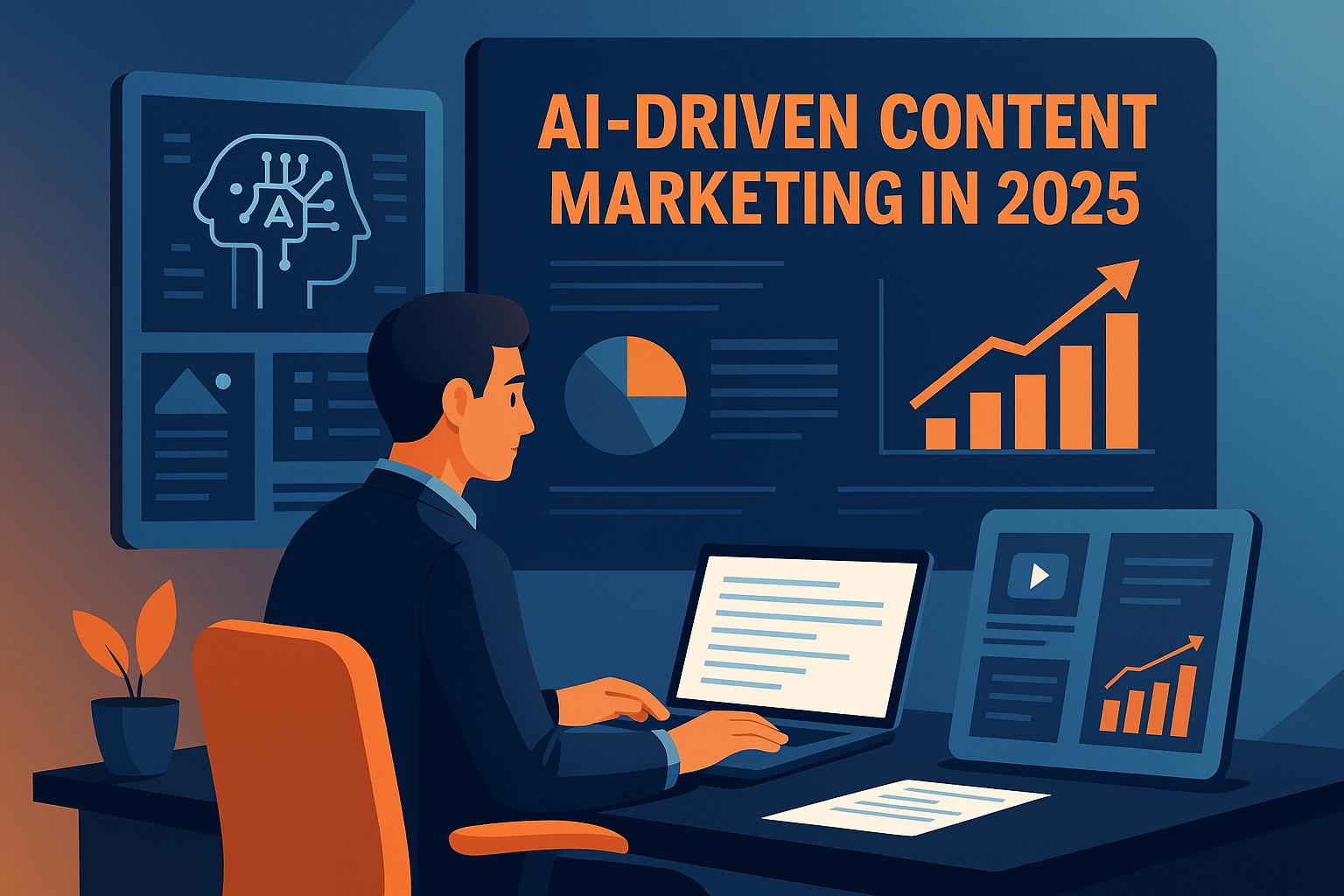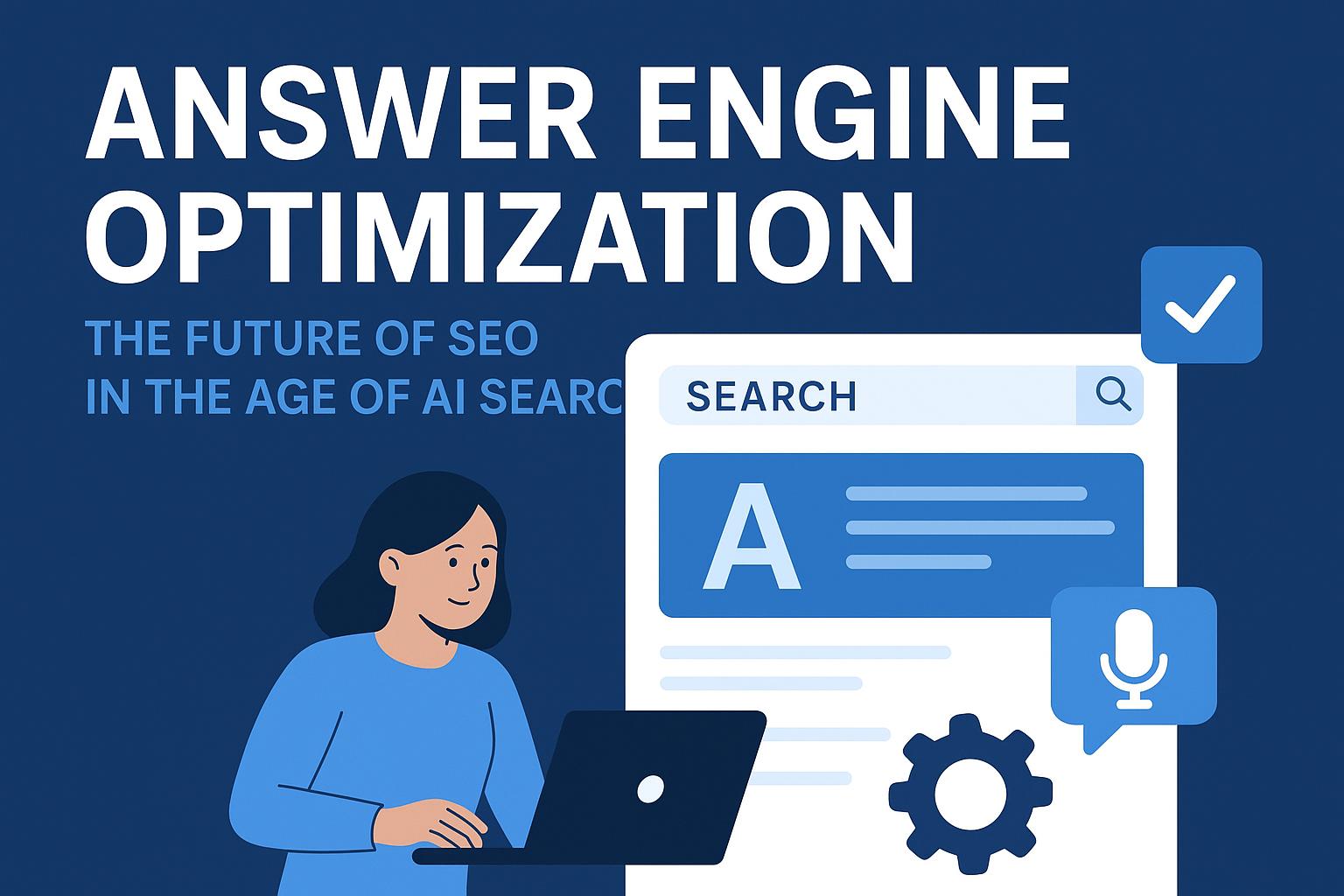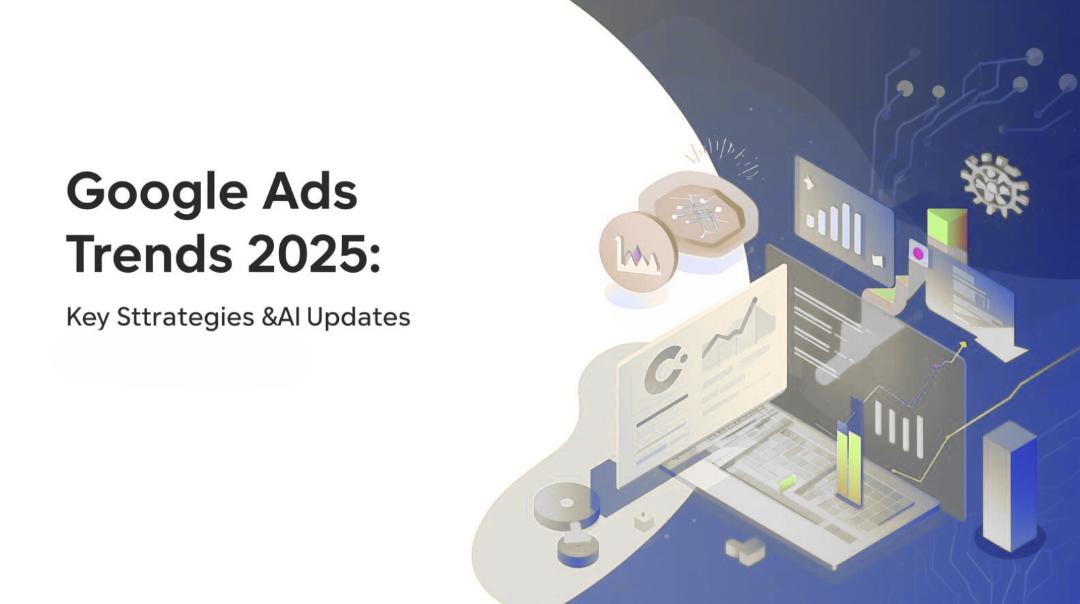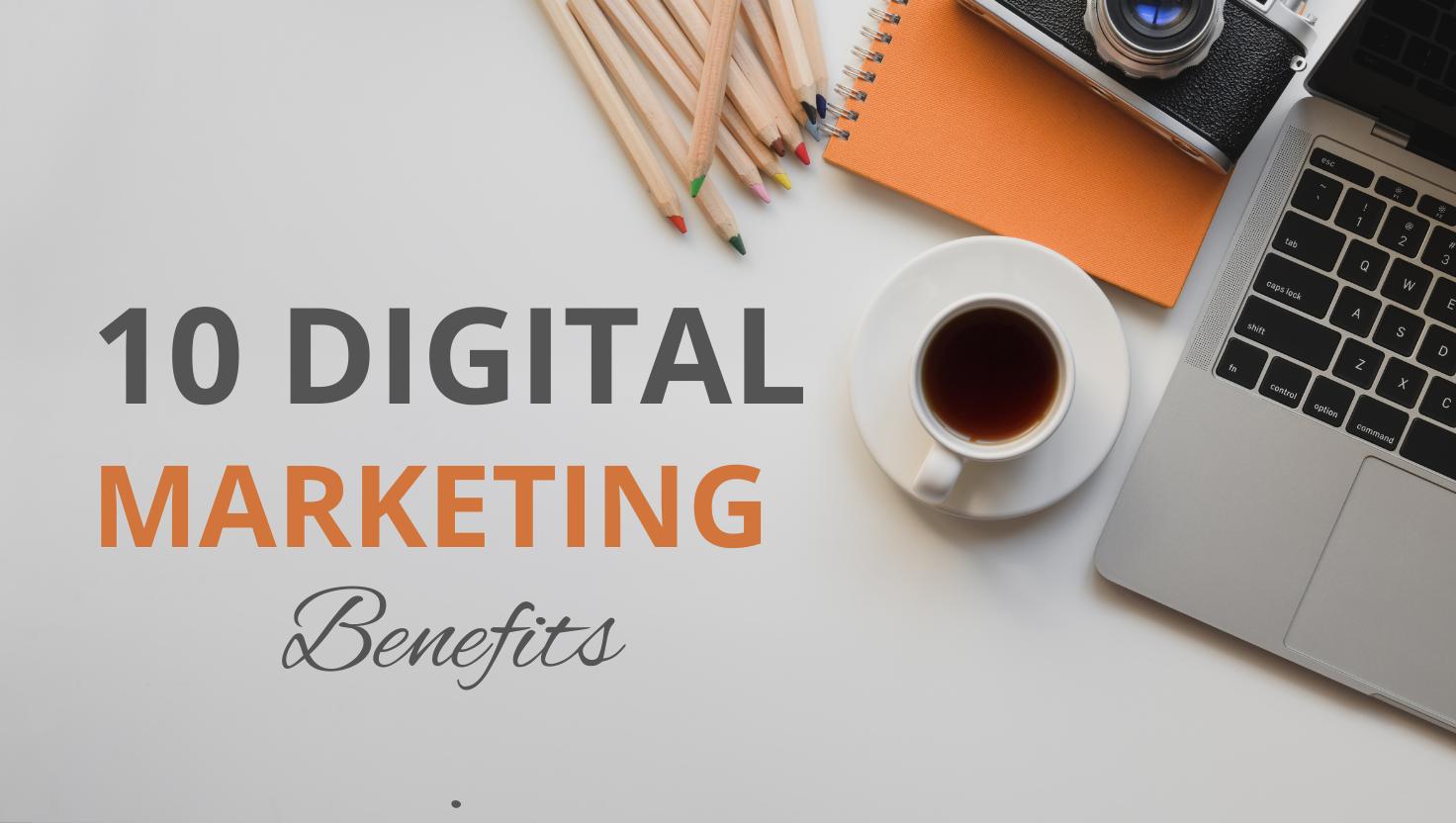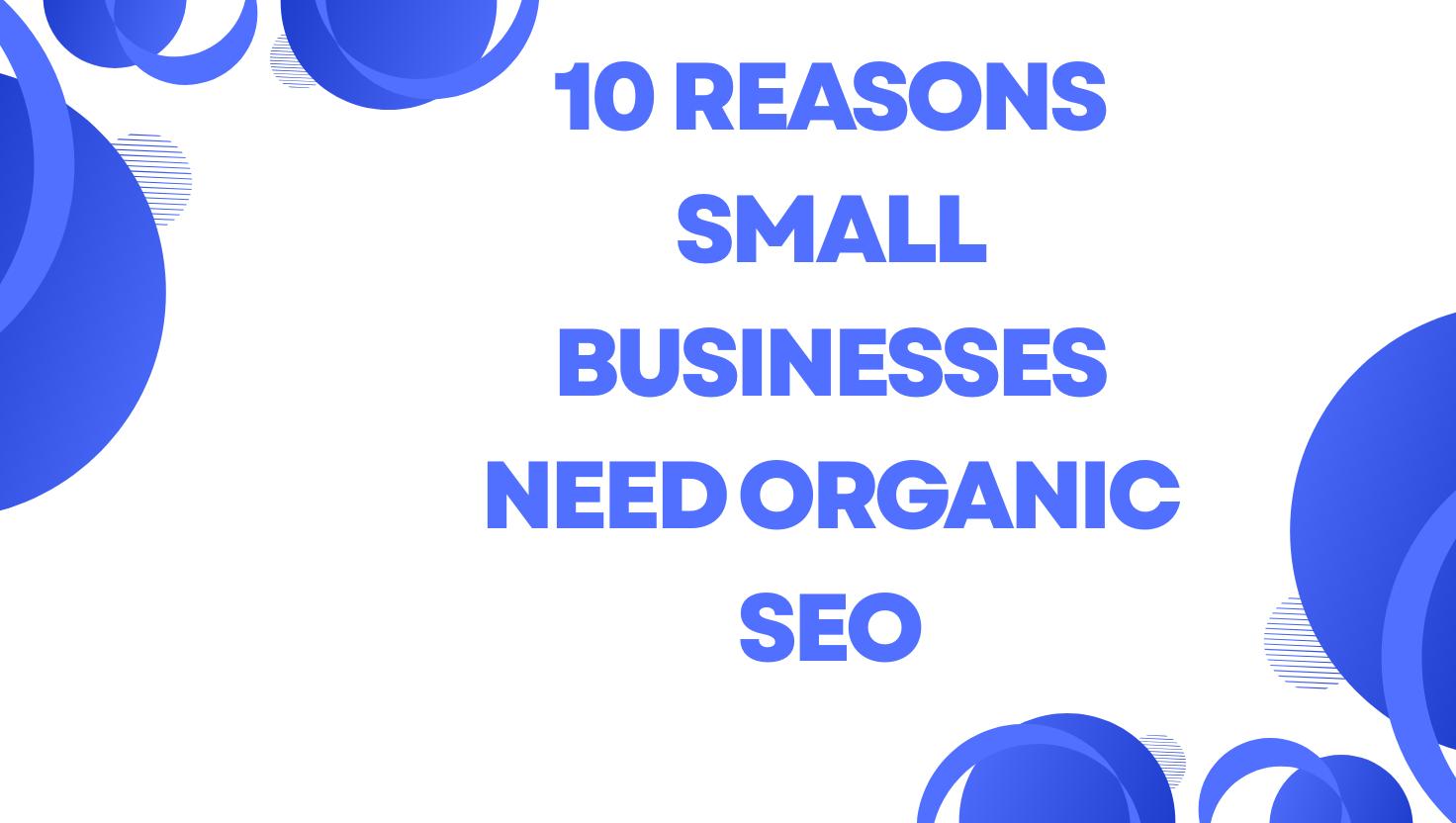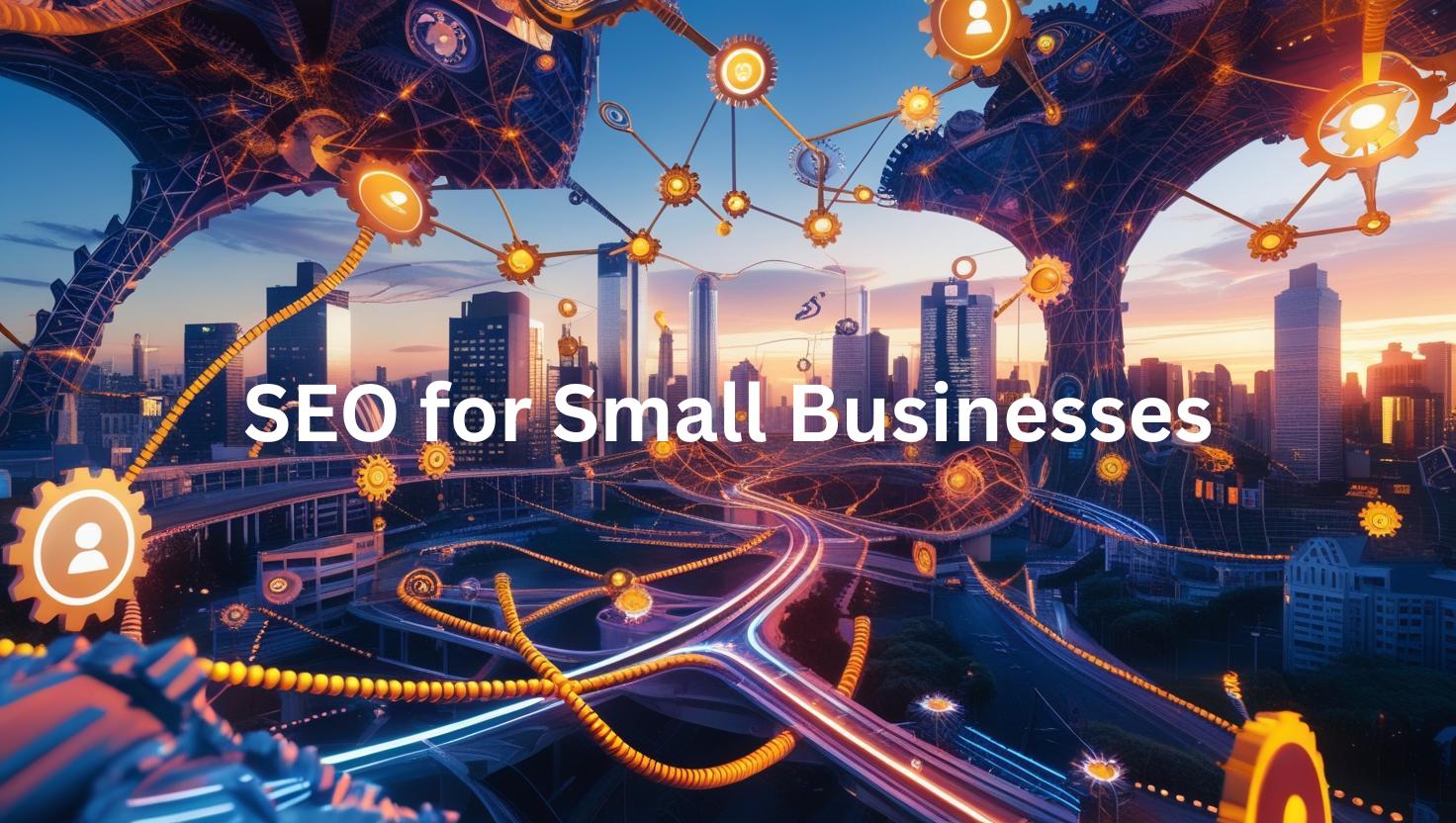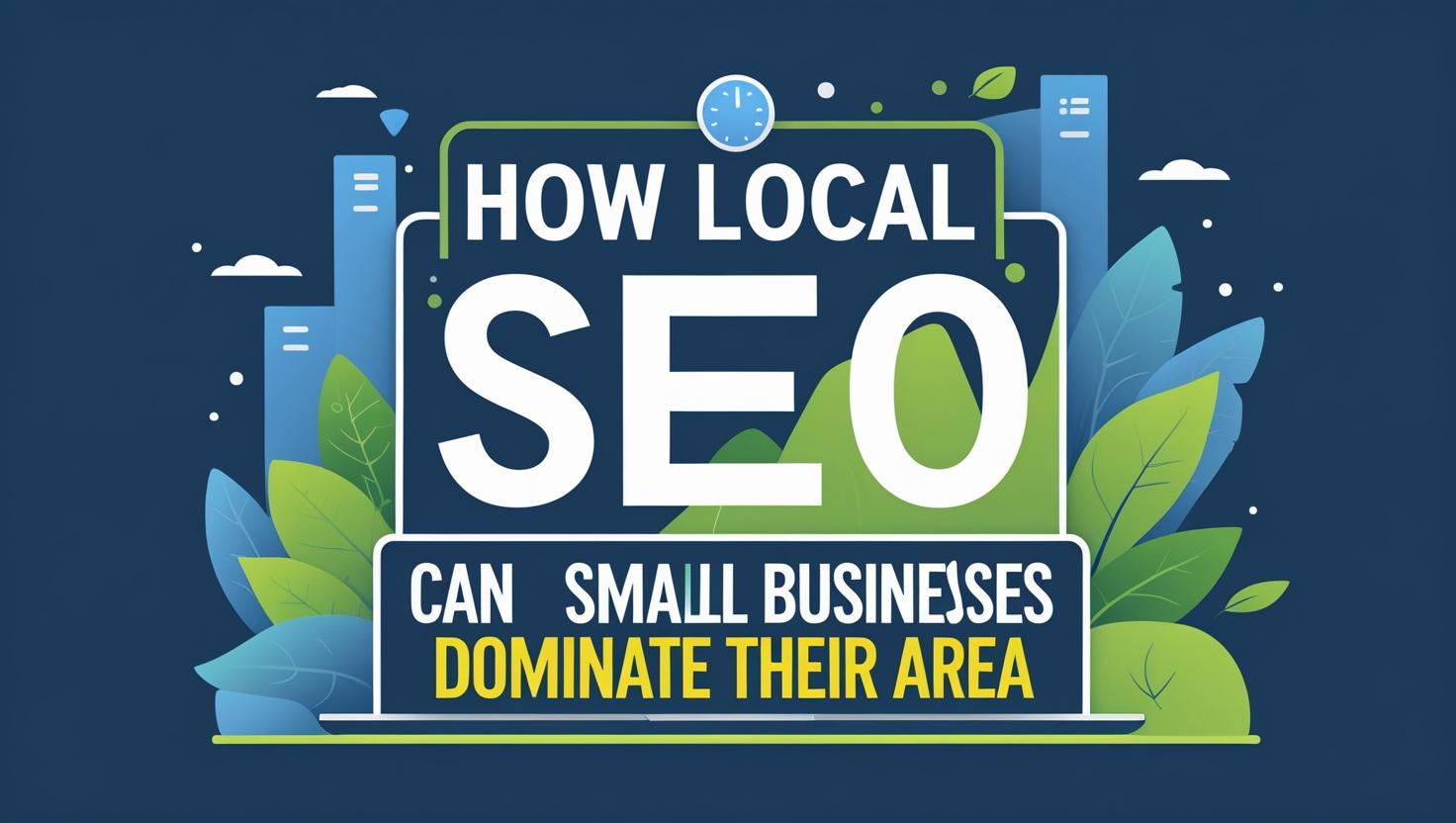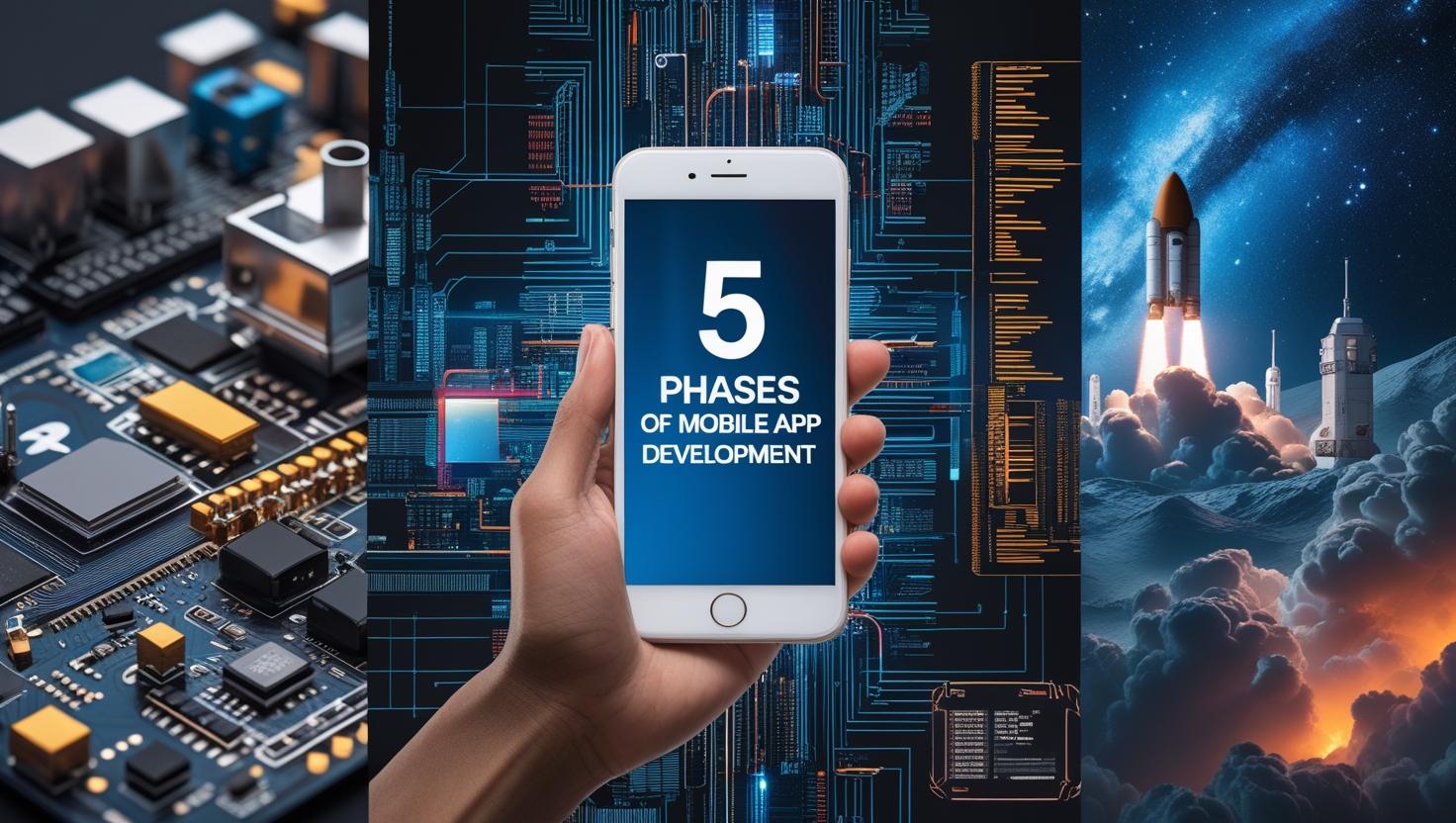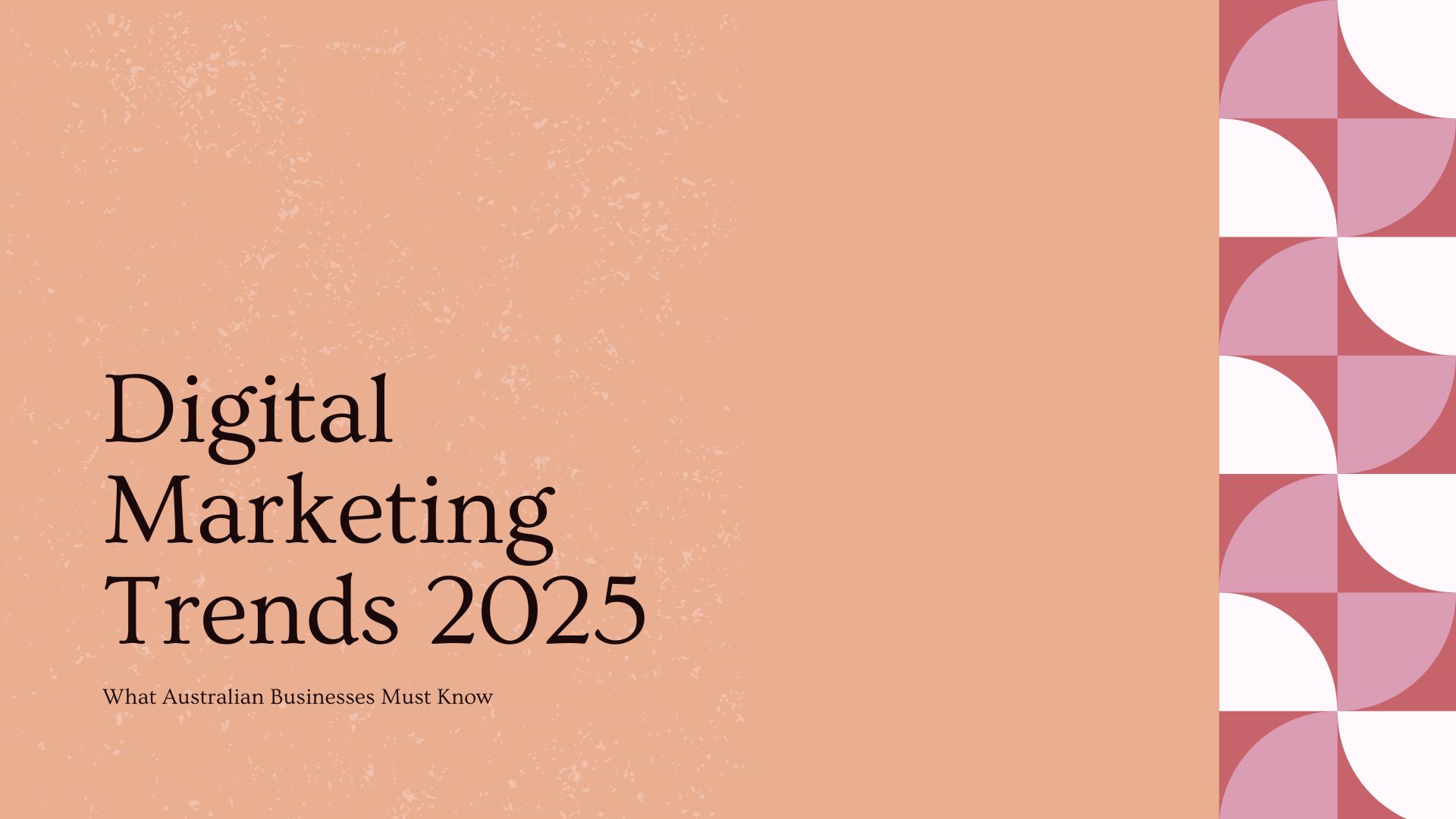All marketers desire their content to work, not merely be present on the internet. But in 2025, when everybody is posting blogs, videos, and social updates, the problem is not how to create content — it is how to create content that generates conversions. That is precisely where AI-driven content marketing comes into play. Artificial Intelligence isn’t replacing marketers. It’s helping them think smarter, act faster, and connect with audiences more personally than ever. In this article, we’ll dive deep into how AI in content marketing is changing the way brands attract attention, engage readers, and turn clicks into conversions. This evolution connects directly with what we explain in our pots on Answer Engine Optimization (AEO). Showing how AI algorithms are changing. The New Era of AI and Content Marketing Some years back, marketers used intuition and experience to determine what to publish next. Nowadays, AI for content marketing does the heavy lifting by analysing audience behavior, probing search intent, and making forecasts on which type of content will work best. With content marketing AI, brands can: This evolution of assumption to precision is what drives AI-driven content strategy as the defining driver of 2025. How AI Transforms the Content Marketing Landscape Let’s dissect how AI and content marketing are collaborating: Smarter Audience Understanding AI applications can analyze enormous quantities of data, including how users interact with search queries, to determine what your audience is looking for before they even search for it. Hyper-Personalization Each reader has a special experience. From personalized product suggestions to live website headlines, personalization fosters emotional connections that drive conversions. Intelligent SEO Optimization With AI-powered content optimization, marketers can identify keyword opportunities, enhance readability, and ensure every piece is optimized for Google’s search intent. Data-Backed Creativity AI provides guidance, but creativity is human. It suggests topics, headlines, and structures based on trends, but humans bring storytelling and emotional richness. AI-Powered Strategies That Actually Convert Below are real-world strategies for leveraging AI in content marketing to increase engagement and sales: 1. Predictive Content Planning AI systems can predict what topics will take off next month or next quarter, keeping marketers ahead of the curve. 2. Smart Topic Generation Using AI content marketing tools, you can find buried keyword opportunities and trending questions that your competitors have yet to tackle. 3. Real-Time Optimization Rather than waiting for analysis reports, AI monitors performance in real time and makes recommendations for edits that can boost click-through rates and conversions on the fly. 4. Audience Segmentation AI divides your audience into highly targeted segments based on interests, behavior, and demographics, making targeted campaigns much more impactful. 5. Conversion-Focused Copy Enhancement AI doesn’t simply write; it enhances tone, clarity, and emotional connection so your content resonates directly with what your audience wants to hear. The Best AI Content Marketing Tools to Try in 2025 If you’re serious about stepping up your strategy, these tools deserve your attention: Tool Best For Why It Matters in 2025 ChatGPT / Jasper Writing and ideation Produces creative content while saving time SurferSEO / Clearscope SEO optimization Aligns your content with the latest Google NLP updates Canva Magic Studio Visual content creation Quickly designs social and blog visuals HubSpot AI / Copy.ai Automation and personalization Segments and nurtures leads with smarter workflows Lately AI Repurposing long-form content Converts blogs into short posts for social platforms Each of these tools uses AI-driven content optimization to make your workflow faster and more effective. Avoid These Common Mistakes When Using AI for Content Marketing While AI offers incredible benefits, it can backfire if used wisely. Be aware of these pitfalls: The answer is balance. Use AI as your creative collaborator, not replacement. Building the Perfect Human-AI Partnership AI brings structure and insight, but emotion and authenticity are still human. The best content strategies for 2025 will combine both the accuracy of AI and the passion of storytelling. For instance, a niche e-commerce brand can leverage AI content marketing tools to discover keywords and send automated emails. However, make sure to include human-written stories, testimonials, and product experiences nonetheless. It is that blend of technology and emotion that creates trust and drives conversions. Future of AI-Powered Content Strategy We are just beginning to scratch the surface of what is on the horizon. Here’s what the near future holds: The marketers who begin evolving now will be the ones at the forefront of tomorrow. Conclusion: AI Is Not the Future — It’s Now By this point, it’s clear that content marketing AI is revolutionizing how brands engage with their audience. It enables the production of smarter, speedier, and more personalized experiences that convert. Whether optimizing for blog posts, campaigns, or developing long-term plans, AI for content marketing can scale your efforts — as long as your creativity remains at the reins. In 2025, content that wins isn’t written; it’s driven by AI and refined by human insight. And that’s the recipe for long-term conversions. Ready to transform your strategy?
Search is changing fast. With AI search engines like ChatGPT, Google’s Gemini, and Perplexity.ai becoming part of everyday life, the way businesses show up online is shifting. Traditional SEO is no longer enough — we’re now entering the world of Answer Engine Optimization (AEO). If you’re running a business in Australia and want your brand to stand out when customers ask AI-powered tools questions, this guide is for you. Let’s dive into why Answer Engine Optimization is the future of SEO and how your business can prepare for it. What Is Answer Engine Optimization? Answer Engine Optimization (AEO) is the process of optimizing your content so that AI-driven search tools can directly pull and deliver your answer to a user’s question. Instead of showing a long list of links like Google traditionally does, AI search engines summarize the best answers and present them instantly. This means your business has two choices: At NetFast, we’ve seen firsthand how early adopters of AEO strategies are already winning visibility in AI search results. Why AEO Is the Future of SEO In short: the old rules of SEO are fading, and Answer Engine Optimization is taking the spotlight. If your business offers services like SEO, Web Design, or PPC Management, getting ahead in AEO ensures customers find you first when they ask questions like: How to Optimize for AEO in 2025 Here’s a clear roadmap to help your business adapt to Answer Engine Optimization: 1. Focus on Direct, Clear Answers AI search prefers content that directly answers a question in 40–60 words. For example: Question: What is Answer Engine Optimization?Answer: Answer Engine Optimization (AEO) is the process of structuring and optimizing content so AI-driven search engines can pull direct answers to user questions. It improves visibility in AI search results, voice search, and featured snippets, making it a critical part of the future of SEO. 2. Use Structured Data (Schema Markup) Adding schema helps search engines and AI tools better understand your content. For example: At NetFast, we help businesses implement schema markup so they don’t just appear in AI search but own the featured answers. 3. Target Conversational Keywords People are searching differently. Instead of typing “SEO agency Sydney,” they’re asking: Your content should include natural, conversational keywords to match how users talk. 4. Build Authority With Content AI search engines value trusted, consistent sources. Blogs, guides, and case studies make your business more “answerable.” You can explore resources on our Blog for examples of how NetFast publishes thought leadership content. 5. Think Local, Not Just Global For Australian businesses, optimizing locally matters. Adding terms like “in Sydney,” “in Melbourne,” or “near me” boosts your chances of showing up in AI-powered local results. That’s why combining AEO with strong Local SEO strategies gives your brand an unbeatable edge. Real-Life Example: Why AEO Matters Imagine a café in Sydney. A customer asks Siri: “Where can I find the best café with free Wi-Fi near me?” Traditional SEO might rank your café on page two of Google. But with AEO, Siri can directly say: “Try Café ABC on George Street. They have free Wi-Fi and great coffee.” See the difference? That’s the power of Answer Engine Optimization. Why Businesses in Australia Should Act Now The sooner you adapt to AEO, the sooner you dominate AI search. If you wait, bigger competitors will claim those top spots. Whether you’re investing in SEO, Social Media Marketing, or Web Design, you need to future-proof your digital presence. At NetFast, we’re helping Australian businesses adjust their strategies to stay visible in the era of AI-powered search. FAQs: Answer Engine Optimization (AEO) in 2025 Q1. What is Answer Engine Optimization in simple terms?Answer Engine Optimization (AEO) is about making your content easy for AI search engines like ChatGPT or Google Gemini to pull as a direct answer to user questions. Q2. Is AEO replacing SEO?No, but it’s transforming it. AEO builds on SEO by focusing on direct, conversational answers instead of just ranking for keywords. Q3. How does AEO help local businesses in Australia?Local businesses benefit because AEO makes them more discoverable in voice search and AI tools when people search “near me” or mention their city. Q4. How can I prepare my business for AEO?Start by answering customer questions directly, adding structured data, and publishing helpful blogs. A digital agency like NetFast can handle the technical setup for you. Q5. What services does NetFast offer to support AEO?We provide SEO, PPC Management, Web Design, and Social Media Marketing — all tailored to fit modern AEO strategies. Final Thoughts The future of SEO is here, and it’s called Answer Engine Optimization. AI search engines will only grow stronger, and the brands that adapt early will lead the way.If you’re ready to future-proof your business and dominate AI-powered search results, talk to the team at NetFast today.
Marketing has reached a genuine turning point. You can no longer think of AI and marketing as something distant; these are the here-and-now tools that separate the leaders from everyone else. While some still debate whether to dip their toes into artificial intelligence, forward-thinking marketers are already swimming in it. They use AI for marketing to craft personalized experiences, automate complex workflows, and even predict customer behavior with astonishing accuracy. This isn’t just about doing things faster. Instead, it’s about completely reimagining how we connect with people, create meaningful content, and drive real, measurable growth. The future of marketing belongs to those able to masterfully blend human creativity with the power of artificial intelligence. Yet here’s the secret sauce that many miss: successful AI marketing isn’t about replacing the human element. Rather, it’s about amplifying it. The most effective strategies pair the incredible analytical power of machine learning with a deep human understanding of emotion, context, and the art of brand storytelling. In this guide, you’ll discover how top marketers are using generative AI for marketing, transforming everything from day-to-day content creation to high-level customer segmentation. You’ll get proven strategies for implementing AI in marketing automation, making sense of predictive analytics, and thoughtfully navigating the ethical side of these powerful tools, referencing our custom software development services as an example of how integration can elevate results. What’s Changing: Key Trends in the Future of Digital Marketing The future of digital marketing is shaped by several powerful trends that are completely changing the game. Hyper-Personalization & Predictive Engagements Modern AI marketing goes well beyond simply knowing a customer’s age or location. Today’s best campaigns analyze real-time behavior to deliver experiences that anticipate what a customer needs—such as what someone clicks on, how long a video is watched, and other “micro-moments.” Consider this: instead of shouting a generic message to a crowd, you’re having a one-on-one conversation where you can offer the right advice at the perfect time. When executed properly, it feels more like a helpful friend than an ad. For more on audience targeting, see our search engine optimization solutions. Generative AI as Co-Creator Generative AI for marketing is now a core member of the creative team. Tools like ChatGPT, Microsoft Copilot, Jasper, and Synthesia help marketing teams brainstorm and draft high-quality content, visuals, scripts, and emails—at an amazing speed. Importantly, these tools work best as creative partners, not as replacements. The sharpest marketers use AI for marketing to get the first draft on the page. Then, they refine the message, check for brand consistency, and add that irreplaceable human touch. Explore more about how this shapes digital experiences in web development. AI-Driven Omnichannel Experience Artificial intelligence in marketing is now making a truly seamless customer experience possible. By pulling together data from your website, app, emails, and even in-store visits, you can deliver a consistent message. This message aligns with customer expectations no matter where or how someone interacts with your brand. As a result, this creates a journey where every customer feels understood and valued. Consequently, relationships grow stronger, and customer lifetime value increases. Discover our system integration solutions for full omnichannel potential. Real-Time Analytics & Adaptive Strategy Previously, you might have launched a campaign and waited weeks to see how it performed. With AI in marketing, however, real-time adjustments become the norm. You can spot trends as they happen, see shifts in customer behavior, and capitalize on new opportunities instantly. This approach transforms marketing from a “set it and forget it” task into a dynamic, adaptive process. How to Use AI for Marketing: Advanced Strategies Putting AI marketing to work takes both smart strategy and practical know-how. Here are several proven approaches—employed by leading companies—to get real results. Generative AI + Human-AI Collaboration The best content combines the efficiency of AI for marketing with the creativity and nuance of human insight. Implementation Strategy: Generate first drafts using AI for blog posts, social media updates, or email campaigns. Next, your team should polish the output to ensure it features your brand’s unique voice, is factually accurate, and aligns with your values. Key Benefits: This hybrid approach lets you scale content production dramatically, yet never at the expense of quality and authenticity that builds trust. If content scale and quality are your goals, learn about our digital marketing benefits. AI in Marketing Automation AI in marketing automation transforms repetitive tasks into smart, responsive systems that work for you. Implementation Strategy: Set up automated email sequences that trigger based on customer actions, such as visiting a specific page. You can use dynamic content that changes with their interests or run ad variations that automatically optimize themselves, similar to what’s described in our Google Ads trends. Key Benefits: Save manual effort, reduce the risk of human error, and improve conversion rates by delivering more relevant, timely messages. Hyper-Segmentation & Predictive Segmentation It’s time to move beyond basic demographics. With AI, you can create incredibly detailed customer profiles based on behavior, sentiment, and predictions about future actions. Implementation Strategy: Use machine learning to spot patterns in your data that a human might miss. Segments can cover who is likely to buy, who’s at risk of leaving, or who has the highest lifetime value. Key Benefits: This results in more effective messaging, a stronger return on investment, and better customer retention since you’re reaching people about what truly matters to them. Need more on this? See our guide to organic SEO for small businesses. AI & Advertising Optimization AI and advertising together are the best solution for maximizing campaign performance and cutting down on wasted spend. Implementation Strategy: Deploy programmatic advertising to automatically find the best audiences and placements for your ads. Test hundreds of ad variations simultaneously to see what works best; for deeper insights, explore digital marketing trends. Key Benefits: Get better ad performance, lower waste, and reach more of the right people with less effort. Influencer & Content Partnerships Powered by AI Influencer marketing’s future uses AI-driven insights to
The world of digital advertising is evolving at an unprecedented pace. You’ve got a winning strategy one minute, and the next minute, a platform update kills the entire game. If you’re a business that’s using Google Ads, this never-ending cycle of change is both a blessing and a curse. Businesses are missing out on significant returns from their ad spend simply because they’re not tracking the newest features and strategic developments. If you’re curious about how to deal with this evolving landscape, you’ve landed on the right page. This guide explores the key Google Ads trends for 2025, including AI-driven keyword initiatives and major shifts in budget allocation. We’ll deliver actionable advice to keep you ahead of the curve and achieve your return on investment. At NetFast, we’re passionate about helping businesses succeed through these changes, converting platform updates into recurring growth. Table of Contents Google Ads Trends 2025: What’s Changing and Why It Matters Keyword Strategy in Google Ads: From Exact Match to AI-Powered Intent Google Ads AI Automation: Smarter Campaigns, Better Results Google Ads Budget Trends: Where Businesses Are Spending in 2025 Future of Google Ads: What’s Next Beyond 2025? FAQs About Google Ads in 2025 Conclusion Google Ads Trends 2025: What’s Changing and Why It Matters As we approach 2025, Google Ads is doubling down on automation and AI. The platform is shifting from a do-it-yourself tool to a more predictive, automated engine. Some of the key changes include the increasing dominance of Performance Max campaigns, the broad adoption of Google Ads AI automation, and a fundamental shift in the way we target keywords. Recent data highlights these digital advertising trends 2025: The most important takeaways from these google ads 2025 trends are straightforward: companies that embrace these shifts soon will have a much healthier return on investment. Sticking to the old ways will only result in wasted spend and lost opportunity. Keyword Strategy in Google Ads: From Exact Match to AI-Powered Intent One of the most significant shifts in the latest Google Ads strategies is the move away from granular keyword control. Broad Match is now the default match type for many campaign setups, encouraging advertisers to trust Google’s AI to find relevant queries. This doesn’t mean keywords are dead; it means the keyword strategy in Google Ads has evolved. Here’s how to adapt: The aim is to balance. Allow the AI to uncover new opportunities with Broad Match, but steer it with tight Phrase and Exact Match keywords for your most important, high-intent search phrases. Google Ads AI Automation: Smarter Campaigns, Better Results How AI is transforming Google Ads 2025. The most noticeable change in Google Ads is the automation aspect. From bidding to creative, AI is designed to optimize all aspects of your campaigns for better performance. Holding on to the past means leaving money on the table. Some of the most compelling new Google Ads insights 2025 regarding AI include: The takeaway here is to collaborate with the AI, not against it. Feed the system good data (such as customer lists), well-made creative assets, and a clear strategic vision. Then, allow the Google Ads AI automation to execute the micro-optimizations. This strategy is a fundamental element of contemporary search engine optimization. Google Ads Budget Trends: Where Businesses Are Spending in 2025 The automation uprising is also transforming Google Ads budget trends. Marketers are reevaluating how they allocate budgets to optimize ROI in an AI environment. The most successful budget allocation in Google Ads campaigns harmonizes automation and strategic control. Here’s what’s changing: To be successful, don’t put all your eggs in one basket. Although Performance Max is strong, it’s a good idea to back it up with standalone Search and YouTube campaigns. This balanced approach allows you to maintain strategic control without becoming overly reliant on one type of automation. An experienced partner can assist with this type of sophisticated custom software development and integration. Future of Google Ads: What’s Next Beyond 2025? Looking ahead, the future of Google Ads will be even more automated, privacy-focused, and integrated. The PPC trends 2025 are just the beginning. We can expect to see more profit-focused bidding options, deeper integration with voice and AI-powered search assistants, and tighter privacy controls that increase the importance of first-party data. To prepare your business for these changes, begin investing today in creating your own customer lists and investigating AI-powered campaign types. Being an early adopter of these digital marketing trends can help gain a significant competitive edge. This kind of planning ensures businesses are ready for the future through scalable mobile app development. FAQs Are exact match keywords still useful?Yes, definitely. While Broad Match is wonderful for discovery, Exact Match keywords are valuable for targeting high-value, specific searches where you know the user intent is strong. They provide you with precision and control where it matters most. Should I move my entire budget into Performance Max?It’s not advisable. It’s best done in balance. While PMax is strong, combining it with traditional Search and YouTube campaigns gives you greater strategic control and does not over-reli on one automated platform. How do small businesses benefit from AI in Google Ads?AI is a great boon to small businesses. It mechanizes the difficult tasks of targeting and creative optimization, which once required large teams. This allows smaller budgets to scale more effectively to keep up with bigger players. What’s the best strategy for reducing wasted ad spend?The strongest tactics are creating an in-depth negative keyword list, utilizing your first-party customer data to inform the AI, and applying Smart Bidding controls to target profitable conversions. Turning Trends Into ROI with NetFast The Google Ads landscape is evolving, but with the right approach, the changes are an enormous opportunity. The three stones of success in 2025 are obvious: an adaptable keyword strategy in Google Ads, intelligent use of Google Ads AI automation, and intelligent budget allocation across Google Ads campaigns. By making early adjustments, you can use these trends as a growth-generating dynamo. At
Are you watching competitors pull ahead while your business struggles to gain online traction? You’re not alone. Many Australian business owners feel overwhelmed by the digital landscape, but here’s the truth: digital marketing benefits can be the game-changer your business needs. At NetFast Technologies, we’ve helped countless Australian businesses unlock massive growth through strategic digital marketing. With over a decade of experience, we’ve seen firsthand how the right digital marketing advantages can transform struggling companies into industry leaders. Ready to discover how digital marketing can revolutionize your business? Let’s dive into the ten most powerful benefits that can drive your success. Why Digital Marketing is Important for Modern Businesses Let’s address the elephant in the room: traditional marketing techniques—like newspaper ads, radio commercials, billboards—are quickly becoming ineffective. Yet 85% of Australian shoppers examine products online before making a purchase. The importance of digital marketing for business is to connect with customers where they spend most of their time: online. Digital marketing not only competes with traditional techniques—it outshines them completely in terms of reach, accuracy, and measurability. 1. Global Reach with Local Precision One of the biggest benefits of digital marketing is the ability to go beyond geographical boundaries while still keeping things locally relevant. A Melbourne company can cater to customers in Sydney, Brisbane, or overseas and still target specific neighborhoods in your immediate area. NetFast Technologies, we’ve assisted many Australian companies in growing beyond their regional markets via strategic SEO services. Our local SEO methods ensure you dominate search rankings in your local area while also building visibility. Digital marketing benefits in Australia include: 2. Real, Measurable Cost Savings Let’s be honest—a prime-time TV spot or billboard in Sydney can cost you a fortune, with no guarantee anyone will pay attention. Digital marketing flips this script. Not only can you start with smaller budgets, but you also get to see how every dollar is performing. In fact, digital marketing campaigns often cost 60% less than traditional methods and deliver double or even triple the leads. For startups and small businesses in Australia, these savings are more than a perk—they’re a lifeline. 3. Ultra-Precise Targeting Not everyone needs what you offer, and that’s okay! The beauty of digital marketing lies in its razor-sharp targeting. You can pinpoint your audience based on age, interests, where they live, what they’re searching for—even if they’ve visited your website before. This is a huge advantage of online marketing over traditional approaches. By showing your ads or content only to those most likely to buy, you cut waste and boost results. Imagine being able to welcome every website visitor with just the right message—that’s what digital marketing does, every day. 4. Real-Time Analytics and Measurable Results Here’s where digital marketing impact on business growth becomes as clear as day. In contrast to traditional marketing, where outcomes are a best guess, digital marketing offers precise analytics for each campaign aspect. Through our web development services, NetFast Technologies incorporates sophisticated reporting mechanisms that illustrate exactly what drives results from your marketing activities. You’ll see which campaigns are producing leads, what content engages viewers, and which channels produce the greatest ROI. Metrics that make a difference: 5. Always-On Customer Engagement Your customers don’t sleep, and neither should your marketing. One of the biggest benefits of online marketing includes 24/7 customer engagement using automated systems, chatbots, social media monitoring, and email sequences. Australian consumers expect to find brands available when they need them. Digital marketing creates numerous touchpoints to foster relationships that build trust and loyalty, which convert to sales. 6. Competitive Advantage in the Digital Landscape As competitors struggle with inefficient marketing techniques, digitally-savvy companies win market share with targeted, measurable campaigns. The benefits of digital marketing are that it can: NetFast Technologies’ digital transformation solutions enable companies to remain ahead of trends and provide innovative customer experiences. 7. Enhanced Customer Experience and Satisfaction Today’s customers want customized, frictionless experiences at every touch point. Studies indicate 73% of customers anticipate brands to be aware of their needs and preferences. How digital marketing helps businesses to develop superior customer experiences: Our custom software development services help create integrated systems that support world-class customer journeys. 8. Scalable Solutions That Grow with Your Business In contrast to conventional marketing that necessitates proportional budget escalation for expansion, digital marketing scales effectively. Digital marketing for business growth features systems for managing expanded demand without linear cost escalation. Email marketing platforms manage thousands or millions of subscribers at the same cost. Social media marketing campaigns reach out instantly, while SEO delivers results as your content repositories expand. This scalability makes digital marketing ideal for ambitious Australian businesses. 9. Long-Term Brand Building and Authority Brand-strong businesses beat competitors by 20%. Online marketing opens multiple pathways for long-term brand building through content marketing, thought leadership, and maintaining online presence. The benefits of digital marketing for small businesses in Australia are the development of expertise and building trust that turns prospects into customers. Consistently sharing content makes your business an industry authority, creating competitive benefits hard to emulate. 10. Future-Proofing Your Business The online environment changes fast, but companies with solid digital roots recover well from transformations. Faced with algorithm changes, new social media platforms, or shifting consumer attitudes, digitally equipped businesses pivot seamlessly while others falter. FAQs What are the main digital marketing benefits for small businesses in Australia? Digital marketing helps small businesses reach more customers, boost leads, and compete with bigger brands—without a huge budget. Results are measurable and cost-effective. How does digital marketing help businesses grow faster than traditional marketing? With digital marketing, you can target the right audience quickly, track what’s working, and scale what delivers results. This means faster, smarter business growth. Why is digital marketing important for Australian businesses specifically? Australia’s vast market and digital habits make online marketing essential. It helps businesses connect with local and national customers cost-effectively and stay ahead of competitors. What’s the biggest advantage of digital marketing over traditional advertising methods? The top
Picture starting your own passion business. You’ve invested your heart, soul, and savings to develop a product you truly believe in. You design a stunning website, throw open your doors, and. crickets. You’re invisible in the massive online market, unable to get your product seen by the customers you know you can help best. It’s a familiar tale for many Australian small businesses, overpowered by deeper-pocketed competitors with enormous advertising budgets. So, how do you push past the noise? The secret is organic SEO. Unlike temporary visibility through paid advertising, organic search engine optimization is a long-term, potent method that creates a straight line between you and your perfect customers. It’s not merely a marketing strategy; it’s an anchor that guarantees your company is discovered by people actively seeking what you have to offer. Let’s dive into why organic SEO marketing Australia is more crucial than ever for small enterprises looking to succeed in 2025. Why Small Businesses Need Organic SEO in 2025 Consumers’ behavior today is different from how it used to be. If someone requires a service or product, they will first look it up on Google. If your company doesn’t show on the first page of search results, then you might as well not exist. This is where SEO for small businesses is no longer negotiable.Organic SEO is the great equalizer for small businesses. Organic SEO represents a clear way to boost online presence, establish real credibility with your audience, and all of this at an affordable price. It’s smarter not to spend more, but play more. 10 Reasons Organic SEO Is Essential 1. Builds Trust & Credibility Ranking high on Google is not merely about visibility; it’s an endorsement. Consumers naturally prefer organic results to sponsored results. When your site appears at the top, it conveys to prospective buyers that you are an authoritative and reputable source in your business or category. This trust is the key to long-term customer relationships. 2. Cost-Effective Marketing Face facts: small businesses live on tight budgets. Pay-per-click (PPC) advertising brings instant traffic, but the expense adds up, and the moment you discontinue paying for it, your visibility disappears. Organic SEO is an investment, however. The work you put into it today continues to generate traffic and leads for months and even years to come, providing a significantly greater return on investment. 3. Boosts Local Visibility For companies with a physical presence or service boundary, local SEO is a difference-maker. Searches such as “cafe near me” or “plumber in Melbourne” are incredibly prevalent. A solid organic SEO campaign puts you showing up in these pivotal local searches and on Google Maps, bringing foot traffic and calls right to your doorstep. As our guide to how local SEO helps small businesses outlines, dominating your local market is well within reach. 4. Long-Term Growth Strategy Paid advertising campaigns are sprints; Organic SEO is a marathon. It’s a long-term, sustainable asset that accumulates over time. As you establish your site’s authority and content bank, your rankings stabilize and generate a steady stream of traffic that doesn’t rely on a daily ad budget. 5. Drives Qualified Traffic Organic search engine optimization puts you in touch with customers at the exact moment when they are searching for a solution. With the right keywords about your products or services, you get a highly motivated audience that is prepared to take action. This translates to higher conversion rates and a more effective marketing funnel. 6. Improves User Experience Google’s ranking algorithms prioritize websites that offer a great user experience (UX). This means factors like site speed, mobile-friendliness, and easy navigation are crucial for SEO. By focusing on optimized organic SEO concepts, you’re not just pleasing search engines—you’re creating a better, more engaging experience for your visitors. 7. Outshines Bigger Competitors SEO evens the playing field. A small business with local reach can beat a national company with a clever organic SEO strategy Australia. Through niche keyword targeting, developing helpful content focused on your area, and concentrating on a better user experience, you can establish your niche and compete strongly. 8. Supports Content Marketing Content fuels your SEO engine. Well-written blog posts, guides, and videos assist you in ranking for more keywords and build your brand as an authority. Each piece of content you produce is another chance to show up in search engines and engage with your audience. Keeping your finger on the pulse of digital marketing trends keeps your content fresh and powerful. 9. Measurable & Trackable Results The effect of your SEO work is extremely quantifiable. With free tools such as Google Analytics and Google Search Console, you’re able to monitor keyword rankings, organic traffic, conversion rates, and more. This information gives you priceless insights into what’s proving effective, enabling you to refine your strategy to optimize it even further. For deeper analysis, see our guide to the top SEO tools. 10. Future-Proof Strategy Search engines continue to evolve, with voice search and AI playing a greater role. An organic SEO foundation makes your business more responsive to such developments. By concentrating on excellent content and a good user experience, you bring your strategy into alignment with the long-term objectives of search engines, turning it into a lasting investment for the future. Strategic Organic SEO Guides for Small Businesses An effective organic SEO strategy Australia is founded on some prominent pillars: Powerful Organic SEO Tips Ready to take action? Below are a few powerful organic seo secrets you can apply today: Choosing the Right Organic SEO Company While you can accomplish some of the SEO work on your own, engaging an organic seo company Australia can speed up your outcomes. Find an agency with experience, clear reportage, and a strong understanding of your sector. Professional guidance can save you time and allow you to avoid making mistakes as you traverse the ins and outs of constantly changing SEO strategies for 2025. Build Your Digital Foundation An organic SEO strategy is no longer merely an option
The online market in 2025 is more competitive than ever before. As a small business in Australia, it can be a daunting prospect to stand out online with the likes of large brand names taking over advertising with huge budgets and resources. It’s like you’re screaming into thin air and fighting to be seen by customers you know you can best meet. But what if you could level the playing field? With intelligent search engine optimization for small companies, you can. SEO is not just for multinational corporations; it’s a powerful, economical weapon that enables you to reach local customers actively looking for your goods and services. With the proper strategies, you can scale the Google rankings and draw in the traffic that really matters.Let us venture into why SEO for small businesses is important and proven strategies that you can employ to make it work. Why SEO Is Important for Small Businesses in 2025 Small business SEO investment is not merely a marketing strategy; it’s a business imperative. As one of Australia’s top digital marketing agencies, Netfast has witnessed firsthand how a strong SEO foundation can revolutionize a local business. Benefits of SEO for Small Business Growth Why Your Business Needs SEO The numbers don’t lie. Over 90% of online experiences begin with a search engine. For businesses with a physical location, local searches are even more critical, driving foot traffic and phone calls directly from Google search results. As trends shift towards mobile-first browsing and voice search, having a strong online presence ensures you’re visible wherever your customers are looking. Effective search engine optimization is no longer optional—it’s essential for survival and growth. Core Elements of SEO for Small Business Websites In order to achieve SEO marketing for small business owners, you must target three specific areas. On-Page SEO for Small Companies On-page SEO means optimizing the items on your website. That means crafting good meta titles and descriptions, making use of header tags (H1, H2, H3) for your content layout, and placing keywords naturally throughout your pages. It’s also about making your content readable and adding value to your visitors. Technical SEO Help for Small Businesses Technical SEO focuses on the technical aspects of your website to make it crawlable and indexable for search engines. Some of the major areas are site speed, mobile-friendliness, and generating an XML sitemap. A technologically strong website provides a better user experience, which Google appreciates with higher rankings. Content & SEO Marketing for Small Business Success Content is the fuel for your SEO machine. Producing useful content such as blog posts, guides, and FAQs allows you to target long-tail keywords and establish your business to be an authority. Not only does this direct organic traffic, but it also creates topical authority, which makes your whole site stronger in search. 10 Actionable SEO Strategies to Rank Higher Ready to begin? Below are ten useful search engine optimization tips you can apply. Common SEO Mistakes Small Businesses Should Avoid FAQs What is SEO and why is it important for small businesses?SEO is the process of optimizing your website to rank better in search engines such as Google. It’s critical for small businesses because it generates organic traffic, establishes credibility, and reaches customers actively searching for your services. How can I improve my website’s SEO quickly?Quick wins include on-page SEO: optimizing titles and meta descriptions, and setting up your Google Business Profile. But true SEO magic is an ongoing effort. What are the advantages of search engine optimization for small companies?The primary benefits are greater visibility, lasting traffic without an ad spend, greater credibility, and a superior return on investment than with older marketing methods. Which SEO tools are worth using in 2025?Google Search Console and Google Analytics are must-haves and free. For deep analysis, industry-standard tools like SEMrush and Ahrefs are useful. Do I need professional SEO services for my business?While you may be able to handle some SEO yourself, a professional agency such as Netfast can bring the experience and resources required to see a big impact sooner. If you’re committed to growth, get professional seo help for small business. Start Your Journey to Page One Search engine optimization for small businesses is no longer an optional perk—it’s a 2025 growth necessity. By establishing a solid foundation with on-page, technical, and local SEO, you can play on the level of big brand names and draw in a consistent base of highly qualified buyers. The journey to the first page of Google is achievable with the right strategy. Don’t wait. Start by implementing just one of the tips from this guide today and move your business closer to the visibility it deserves.Ready to take your SEO to the next level? Contact Netfast today for a tailored strategy.
Local search is the new arena where the “Small Businesses” finally have a fighting chance against large corporations. No secret exists that large corporations spend millions, even billions, on national advertising. Smart small business owners know that local SEO for small businesses is a better investment. It offers a more precise way to target customers. When individuals search for a local service, they intend to purchase. These people are not just browsing; they are ready to make a purchase and want a quick solution. When a business optimizes for local SEO services, it positions itself to attract customers. This helps attract motivated customers when they are searching. This guide explains everything you need to know. It shows how local SEO strategies can help you become the top choice in your neighbourhood! What Is Local SEO and How Does It Work? Local SEO is the method to optimize your online presence for attracting business from location based searches. With local SEO, businesses focus on marketing themselves in their local search optimization. They aim to attract customers in a specific district, city, or region. Improving their visibility on search engines achieves this. When a user searches for “coffee shop near me” or “plumber in Melbourne,” search engines use smart algorithms. These algorithms help show the user the best local results. These algorithms consider factors like distance, relevance, and importance. They decide which businesses appear in the local pack. This pack shows the top three results along with a map. The system operates based on advanced signals of location. Search engines look at your business details, website content, customer reviews, and online references. They use this information to find your geographic area and service region. Top Benefits of Local SEO for Small Businesses Local SEO for small businesses offers tangible benefits that affect the bottom line: Increased Visibility in Your Market: When optimized well, your business will appear in local search results, Google Maps, and Google+. This visibility helps you reach customers when they are ready to buy. Higher Conversion Rates: Local searches have better conversion rates than non-local searches. People who search locally are often closer to buying. They are prepared to act now. Cost-Effective Marketing: It is much cheaper when compared to traditional advertising methods that you may use. Once you build your local SEO services, it works for you 24×7 with no ongoing ad spend. Competitive Advantage: Many small businesses do not invest in local SEO. This gives innovative companies an advantage over local competitors. Builds Trust and Authority: Consistent local optimization makes your business look reliable. It can also show that your business is an authority in the local area. Key Local SEO Ranking Factors You Need to Know Knowing what are the top local SEO ranking factors in 2025 helps you focus your optimization efforts for the best results. Google Business Profile Optimization Your Google Business Profile resembles your digital storefront. Make sure to fill out each section with accurate details, good photos, and current information. Local searches show that businesses with optimized profiles get much more visibility. Online Reviews and Ratings Matter One of the most powerful local SEO ranking factors on the web are customer reviews. Motivate happy customers to give you reviews, and deal with them respectfully. Reviews help you add content to your site, display it globally, and demonstrate consistent customer support. NAP Consistency Across Platforms For any reason, your Name, Address, and Phone number must match across different sites. Inconsistent NAP details can confuse search engines. This may harm your local rankings. Location-Based Keywords on Your Website Use local search terms in a natural way throughout your content across your site. Terms such as “Melbourne web design” or “downtown coffee shop” will help search engines determine your geographical focus. Local Citations and Directory Listings Commitment to local SEO tools and directories will help you rank for local search. Quality, credibly related directories are more important than just sheer quantity. Earning Local Backlinks for Authority Links from local businesses, community groups, and local media show geographic relevance. They also help build domain authority in the area. How to Optimize Your Website for Local Search Visibility Your site is the cornerstone of effective local search optimization. Start by improving responsiveness. Most local searches happen on mobile devices. Google favors websites that are mobile-friendly. Integrate location-based keywords organically in your content, but don’t overdo keyword-stuffing. Create specific pages for each city and region you serve. Provide unique content that is valuable to each market. Add schema markup to your website. This helps search engines understand your business and location information better. This organized data can help with your appearance in the search results and clicks. Enhance your site’s speed for an improved user experience. Slow websites annoy users and hurt your search ranking. This is especially true on mobile devices, where most local searches occur. Local SEO Content Strategy: Blogging and Community Topics By creating content for local audiences, you show that you are an expert. This also helps you appear in local search results. Write about area events, local engagement, and the specific local challenges your business addresses. Create features on local points of interest, neighbourhood how-tos and community resources. This design appeals to traffic in your area as you show your affinity for your local area.Try producing content that responds to frequently asked local questions or local issues. With proper local digital marketing trends, this can be a great way to enhance your local SEO exposure. Measuring the ROI of Your Local SEO Strategy Monitor your local SEO with Google Business Insights, Google Analytics & other local SEO tools. Track local search impressions, website visits from local searches, phone calls and direction requests. Track increases in foot traffic, online-to-offline conversions, and customer acquisition cost (CAC). These measurements show the true impact to your business of investing in local SEO services.Create conversion tracking for local actions such as calls, form submissions and appointment bookings. This information is helpful in understanding which SEO strategies 2025
Creating a successful mobile application demands more than merely having an excellent idea. You need a clear, step-by-step plan to turn your idea into a working and easy-to-use product. This guide explains the mobile app development process in five simple stages. Great for entrepreneurs, startups, and businesses. Whether you are a beginner or an experienced developer, knowing the mobile app development phases is important. This knowledge helps you make better decisions. It also guides you on what to do next. You can sidestep errors and avert possible problems. So, what are the five main stages that every successful mobile app development company follows? Phase 1: Discovery & Strategy — Build a Strong Foundation The initial phase of the app development process includes conducting research and planning. This basic phase is the foundation for all the stages that follow. Define Your App’s Purpose What is the problem you will be solving with your app? Who is your target audience? The key question to ask is about the main value of your application. Market Research and User Personas Study your competitors. Identify gaps they missed. Next, create user personas. This will help you understand the actions, goals, and challenges of your target users. MVP Planning and Feature Selection Select your MVP features. Focus on what your app needs when launching. Add advanced features later. Platform Selection Choose between iOS, Android, or both. But if you’re on a budget, most mobile app developers Australia recommend starting with a single platform. Deliverables: Many apps fail because they overlook this crucial step. Prioritize strategy before development. Phase 2: UI/UX Design — Design for Users Once you determine the strategy, you can move to the next mobile app development process — UX design. Wireframing & Layouts Begin with rudimentary wire frames that illustrate the app’s layout. Keep it simple and functional. User Journey Mapping Think about what the user flow will be through your app. This is clear and enhances readability. Visual Design & Branding Utilise attractive colour, typography, and imagery that reflect your brand. Ensure consistency across all screens. Interactive Prototypes Create clickable mockups. Show them to users and gather feedback before you write a line of code. Accessibility & Compliance Design your app for everyone. Abide by accessibility requirements to expand your reach. An attractive app is worthless if users cannot comprehend how to navigate it effectively. Phase 3: Development — Turn Designs Into Reality In this stage, your team is developing the code to bring your design to life. Agile Development Slice the mobile app development into tiny sprints. This also makes it more accommodating if priorities shift. That includes servers, databases, and APIs. The part that users don’t see makes it all run. Frontend Development The frontend is what users interact with—screens, buttons, and features. Technology Stack Choose between native applications (iOS, Android) or cross-platform options using React Native or Flutter. Continuous Integration Develop and test every feature as you create it. Address issues promptly and maintain a clean codebase. Start small. Launch with your MVP. Improve as you grow. Phase 4: Testing & Quality Assurance — Ensure Excellence The team needs to test the application carefully before it launches. They need to make sure it works on all devices and in every situation. Types of Testing Multi-Device Testing Evaluate on smartphones, tablets, and different operating systems. Confirm it functions optimally everywhere. Bug Fixes & Optimization Log and fix issues. Improve speed and stability. App Store Readiness Prepare your listing by including a title, images, description, and keywords. Follow Apple/Google standards. Test with real users. Developers frequently overlook things that the public won’t. Phase 5: Launch & Post-Launch Maintenance — Stay Competitive The application is operational — yet the launch is merely the beginning. Launch Strategy Get your app out through PR, influencers, social media.” Consider initiating a gentle rollout prior to unveiling the full program. App Store Optimization (ASO) Keywords, imagery, and app descriptions. Concentrate on your keywords, visuals, and app descriptions. Effective ASO boosts downloads. Collect User Feedback Monitor user interactions with your app using platforms like Firebase or Mixpanel. Gather feedback through surveys and customer reviews. Updates & Maintenance Regular updates improve the app’s performance and features. This keeps users engaged. Scaling Your App Add new features and enhance the backend as you build your user base. Steady persistence results in enduring achievement. Continue beyond the launch. Common Pitfalls to Avoid Your Next Step in Mobile App Development Understanding these five stages of mobile app development minimizes risk and enhances your chances of success. We are NetFast Technology – mobile app development Australia, Our services include custom software, integration, and full-cycle web development. Whether you’re starting from the ground up or expanding a current mobile app, our specialists are here to assist you. Ready to build your app? Get in touch with us – App Developers Australia. Faqs What are the key phases in the mobile app development process? The mobile app development process has five main stages. 1. Discovery and Strategy 2. UI/UX Design 3. Development 4. Testing and Quality Assurance 5. Launch and Maintenance Each step helps your app be usable and user-friendly. This aligns your app with user needs and business goals. Collaborating with a reputable mobile app development company such as NetFast Australia ensures your project progresses seamlessly through every phase. Why should I hire mobile app developers in Australia for my project? You can gain a lot from hiring mobile app developers Australia. For starters, they understand the local market, bodyboard, lay, country, no, and all their work hours align with yours. Companies like NetFast Australia combine global tech knowledge with local insights. This helps them create mobile apps that are tailored to businesses, scalable, and cost-effective. Local developers also allow for quicker collaboration and post-launch support. How long does mobile app development take from starting to launch? Mobile app development timeline normally lasts from 3 to 9 months, taking complexity, operating system, and features into consideration. Some simple apps do not
By 2025, digital marketing industry trends will continue to evolve. Your current adaptability will determine your success in 2025. In Australia, brands contend with shifting consumer appetites, increased tech adoption, and regulatory changes. This guide examines new platforms and AI-driven marketing. It explores the latest digital marketing trends 2025. Companies can use this information to stay competitive. 1. AI-Driven Marketing Beyond the Hype Artificial intelligence is now an imperative, not an option. Using NetFast Tech’s intelligent Open AI integration tools, businesses are able to work with AI in a secure way. (Inner link: Combine your AI tools with the custom software development). 2. Search Marketing & SEO — Smarter in 2025 The speed of evolution is now moving faster than ever before. These white-hot digital marketing industry trends ensure that users can find your site, no matter how they search. 3. Paid Media & PPC — Automated, Integrated, Effective AI automation finally takes over paid advertising: Let NetFast optimize your campaigns. Our bespoke web development services get data tracked in the right manner that drives higher ROI. 4. Social Media Marketing – Short, Sharp & Engaging Social is still a star performer, with emerging formats taking the lead: These marketing trends 2025 are essential for brands that want to remain relevant and appealing. 5. Email Marketing – Hyper-Personalized & Interactive Email marketing continues to be effective as it evolves: Integrating email platforms with integration solutions such as NetFast ensures that personalization remains powerful, safe and scalable. 6. Content Marketing — Quality Over Quantity In the face of the AI content deluge, original, expert-led content shines: These are the future of digital marketing—building long-term engagement and boosting SEO. 7. Privacy & Compliance — Building Consumer Trust Reforms to Australia’s Privacy Act change the way data collectors gather and use data. This is key to the future of digital marketing trends in 2025. 8. CX & Omnichannel Integration – Seamless Experiences Customers today expect: ResonateCX reports that 65% of consumers are ready to spend more for better products and experiences. This is an important trend in digital marketing in Australia. 9. Emerging Channels: Voice & Visual Commerce The future is both seen and heard: Here are the marketing trends 2025 that make the discovery to conversion. 10. Martech Stack Optimization Technology tools evolve to assist other technology tools in evolving. The face of business software evolves to drive innovation: NetFast’s platform integration solutions deliver scalable tech stacks that keep you ahead of the curve, marketing-wise. 11. Local Focus for Australian Brands Here are activities for businesses in Melbourne, Sydney, Brisbane, and beyond: These digital marketing trends for 2025 will help Australian brands stay competitive in local and global markets. 12. Skills Layer: Human + Machine Collaboration As AI takes on more tasks, human marketers must adapt and grow: This combination of human+AI is the secret to digital marketing success in 2025. Final Thoughts Keeping up with the latest digital marketing trends is no longer a choice. Enter AI, data compliance and omnichannel CX — businesses must innovate quickly. The Future of Digital Marketing Trends 2025. They will also develop a strong foundation to grow and stay ahead in Australia’s competitive market. Ready to lead the charge? Contact NetFast Technologies today to turn 2025’s trends into your brand’s success story. Ready to lead the charge? Get in touch with NetFast Technologies to convert 2025’s trends into a success story for your brand.
- 1
- 2









